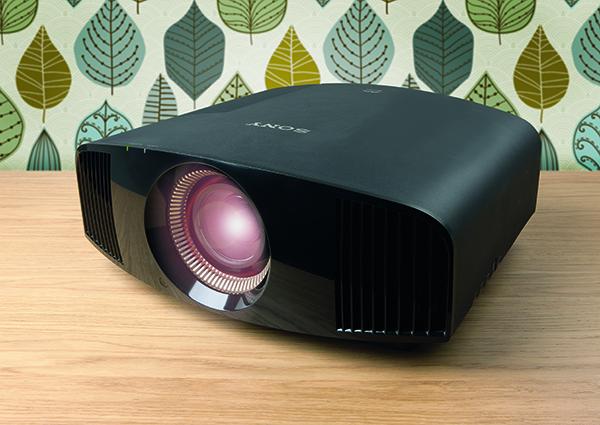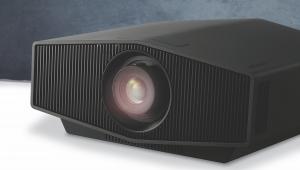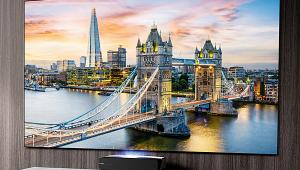Sony VPL-VW360ES 4K HDR projector review

 Sony’s current 4K PJ range has tried harder than any before to offer something for everyone. The recently reviewed £5,200 VW260ES brought Sony’s native 4K SXRD projection system to a more affordable price point. The £15,000 VW760ES added laser illumination to target the brightness and colour needed for a true high dynamic range picture performance. The £20,000 VZ1000ES makes premium projection a ‘lifestyle’ proposition.
Sony’s current 4K PJ range has tried harder than any before to offer something for everyone. The recently reviewed £5,200 VW260ES brought Sony’s native 4K SXRD projection system to a more affordable price point. The £15,000 VW760ES added laser illumination to target the brightness and colour needed for a true high dynamic range picture performance. The £20,000 VZ1000ES makes premium projection a ‘lifestyle’ proposition.
It turns out, though, that the sweet spot of Sony’s varied projector offering is the £7,000 VPL-VW360ES under scrutiny here. Draw up a 'price' and 'performance' Venn diagram for 4K projection, and you'll find the words 'Sony VPL-VW360ES' sitting in the middle.
'I... am your father'
The unit looks and behaves a lot like its more affordable stablemate. Its ‘squashed Darth Vader helmet’ shape is essentially identical to the VW260ES [see HCC #280], and while its gritty finish and golden lens detailing add a degree of opulence, it doesn’t shout ‘luxury’ as loudly as, say, SIM2’s Nero 4 UHD.
The connections, again, are nothing special. There are two 12V triggers, but only two HDMI inputs, when we’re starting to see much cheaper 4K models offer three. And the HDMIs here share the same bandwidth limitations of Sony's step-down model, meaning that 50p or 60p 4K signals can't be delivered with full 4:4:4 chroma sub-sampling (4:2:0 is used instead).
Setup is the same slick procedure as before. The 2.06x zoom, focus and (vertical and horizontal) image shift options are all motorised and thus controllable via the remote control. They offer plenty of adjustment flexibility, making it easy to adapt the picture size and position to your room.
So what does the £1,800 price bump over the entry-level VW260ES get you? Most importantly, Sony adds a dynamic iris system (Advanced Iris3) capable of adjusting the light output for each image frame, resulting in a claimed contrast ratio of 200,000:1. Sony tellingly refuses to give a contrast figure for the VW260ES.
The other key difference is that the VW360ES supports lens memory, so you can save different zoom and focus settings for different movie aspect ratios.
The same 1,500 Lumens of light output is claimed here. Yet experience suggests the dynamic iris system could make a huge difference to how the PJ performs.
Automatic for the people
The VW360ES automatically detects whether it’s receiving HDR content (both HDR10 or HLG are supported) and adjusts its settings accordingly. In particular, it sets its lamp output to maximum, ramping up brightness. And while you don’t have to stick with the default HDR (or SDR) settings, for the most part they’re pretty effective.
My advice is to plump for the Cinema Film 1 preset and default Cinema Black Pro settings, not to bother with Motionflow motion processing, and push up the Contrast (HDR) setting to around 80.
The higher you set the Contrast setting with HDR, the more it raises the image’s brightness floor. This reduces the light range of HDR pictures, but makes them a whole lot more consistently watchable. Actually, ‘watchable’ is an understatement. The VW360ES’s handling of the 4K Blu-ray of Thor: Ragnarok is stunning.
The sharpness of the image hit me like a Hulk hammer blow. As with the VW260ES, the benefits of Sony's native 4K optics are beautifully apparent. Shots such as those amid the rubbish mounds of Sakaar, or close-ups of Thor, Loki and Hela’s costumes, are deliciously detailed.
There’s also that gorgeous sense of image ‘density’ that only 4K can deliver, making the image look so immediate you feel you could step right inside it and start wielding your own Godly powers. Even the best pseudo 4K solutions can’t match the VW360ES for sheer 4K purity and refinement.
It does no harm to the image’s sharpness that this projector handles motion so cleanly. With the 24p frame rate deployed by Thor: Ragnarok and most other movies it's superior to the majority of projector rivals, and with 50/60p content (one reason to own Billy Lynn’s Long Half-time Walk on 4K Blu-ray) it steps up its cohesive, blur-free appeal.
As for the introduction of that dynamic iris, it works to give this PJ a tangible HDR performance boost over the already decent VW260ES. During the sequence in Thor: Ragnarok where Hela takes on the Valkyrie against a mostly dark but brightly highlighted sky, the range between the picture’s brightest and blackest parts is extreme yet satisfying, giving the image a beautiful, almost painterly quality.
And this projector's improved light control means that it’s less prone than the VW260ES to leaving dark portions within mainly bright shots appearing devoid of detail.
Admittedly, as with all of Sony’s recent HDR projectors, the VW360ES's most ‘balanced’ brightness with HDR content is achieved by raising the contrast setting to essentially reduce the picture’s dynamic range, as described earlier. I have to stick up for this workaround, as it gives a 1,500 Lumens projector – which lacks the native luminance to cope with the full range of a typical HDR image – the potential to do its best with such content.
With this easily tweaked compromise, Sony is just making HDR look better for its consumer base, helped by an efficient dynamic iris that rarely belies its presence with noticeable shifts in black levels and brightness, even with aggressive HDR sources.
Disco inferno
The VW360ES delivers a surprisingly good sense of the wide colour spectrum (liberally) available on the Thor: Ragnarok 4K platter. The punchy tones of Grandmaster’s disco-themed outfit, and surrounding environments on Sakaar, look far more vivid and ‘alive’ than they do on the standard dynamic range Blu-ray. The brightest and most colourful sequences, such as the Sakaar street party, aren't as exuberantly intense as they appear on premium flatscreen TVs, however.
And for a bit more perspective, the VW360ES’s 4K HDR visuals are no match for those delivered by the laser-based VW760ES. Brightness, colour intensity and contrast are all dialled down. Yet the difference isn’t as extreme as the £8,000 price gap between the two might lead you to expect.
The projector supports 3D (something current single-chip 4K DLP models are ignoring) using the active shutter system. Glasses are 'optional' though, and – as usual – we were not supplied any for testing. With the relatively untaxing demands of standard dynamic range pictures, the VW360ES unsurprisingly continues its good work. There's a pleasing nuance and balance to its colour handling, leaving no tones feeling overcooked, while blacks are natural and full of subtle shadow detail. Sharpness remains bountiful with native 4K sources, and even with 1080p material the projected image appears brilliantly crisp and detailed thanks to the impressive upscaling of Sony’s proprietary Reality Creation processing. You shouldn't buy this PJ just to screen 1080p BDs, but such discs won't be done a disservice.
Best in class
Adding to the VW360ES’s picture quality heroics are a lack of such common projector issues as ‘rainbowing' interference, colour striping and excessive running noise. The form factor is manageable, there's a white finish available if you fancy, and ease-of-use is good. The result is a model that not only gives you the best picture-quality-per-pound in Sony’s current range, but also the best 4K and HDR performance currently available below £10,000. Very highly rated, even with its HDMI bandwidth shortfall.
Specification
3D: Yes. Active shutter (glasses optional) 4K: Yes. 4,096 x 2,160 HDR: Yes. HDR10; HLG Connections:2 x HDMI inputs; 2 x 12V trigger; RS-232 port; Ethernet; IR input Brightness (claimed): 1,500 Lumens Contrast (claimed): 200,000:1;
Zoom: 2.06x Dimensions: 495.6(w) x 195.3(h) x 463.6(d)mm Weight: 14kg
Features: SXRD native 4K projector; motorised horizontal (+/-31%) and vertical (+85%/-80%) lens shift; 6,000-hour claimed lamp life in Low mode; up to 300in image; 26dB fan noise; Reality Creation and Motionflow processing; Triluminos colour; lens memory function; Advanced Iris3 dynamic iris; HDCP 2.2 on both HDMI inputs; 1.38-2.83: 1 throw ratio
 |
Home Cinema Choice #351 is on sale now, featuring: Samsung S95D flagship OLED TV; Ascendo loudspeakers; Pioneer VSA-LX805 AV receiver; UST projector roundup; 2024’s summer movies; Conan 4K; and more
|























































